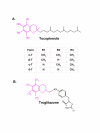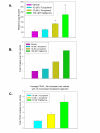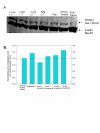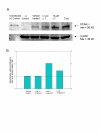Gamma (gamma) tocopherol upregulates peroxisome proliferator activated receptor (PPAR) gamma (gamma) expression in SW 480 human colon cancer cell lines
- PMID: 14521714
- PMCID: PMC222914
- DOI: 10.1186/1471-2407-3-25
Gamma (gamma) tocopherol upregulates peroxisome proliferator activated receptor (PPAR) gamma (gamma) expression in SW 480 human colon cancer cell lines
Abstract
Background: Tocopherols are lipid soluble antioxidants that exist as eight structurally different isoforms. The intake of gamma-tocopherol is higher than alpha-tocopherol in the average US diet. The clinical results of the effects of vitamin E as a cancer preventive agent have been inconsistent. All published clinical trials with vitamin E have used alpha-tocopherol. Recent epidemiological, experimental and molecular studies suggest that gamma-tocopherol may be a more potent chemopreventive form of vitamin E compared to the more-studied alpha-tocopherol. Gamma-tocopherol exhibits differences in its ability to detoxify nitrogen dioxide, growth inhibitory effects on selected cancer cell lines, inhibition of neoplastic transformation in embryonic fibroblasts, and inhibition of cyclooxygenase-2 (COX-2) activity in macrophages and epithelial cells. Peroxisome proliferator activator receptor gamma (PPARgamma) is a promising molecular target for colon cancer prevention. Upregulation of PPARgamma activity is anticarcinogenic through its effects on downstream genes that affect cellular proliferation and apoptosis. The thiazolidine class of drugs are powerful PPARgamma ligands. Vitamin E has structural similarity to the thiazolidine, troglitazone. In this investigation, we tested the effects of both alpha and gamma tocopherol on the expression of PPARgamma mRNA and protein in SW 480 colon cancer cell lines. We also measured the intracellular concentrations of vitamin E in SW 480 colon cancer cell lines.
Results: We have discovered that the alpha and gamma isoforms of vitamin E upregulate PPARgamma mRNA and protein expression in the SW480 colon cancer cell lines. gamma-Tocopherol is a better modulator of PPARgamma expression than alpha-tocopherol at the concentrations tested. Intracellular concentrations increased as the vitamin E concentration added to the media was increased. Further, gamma-tocopherol-treated cells have higher intracellular tocopherol concentrations than those treated with the same concentrations of alpha-tocopherol.
Conclusion: Our data suggest that both alpha and gamma tocopherol can upregulate the expression of PPARgamma which is considered an important molecular target for colon cancer chemoprevention. We show that the expression of PPARgamma mRNA and protein are increased and these effects are more pronounced with gamma-tocopherol. Gamma-tocopherol's ability to upregulate PPARgamma expression and achieve higher intracellular concentrations in the colonic tissue may be relevant to colon cancer prevention. We also show that the intracellular concentrations of gamma-tocopherol are several fold higher than alpha-tocopherol. Further work on other colon cancer cell lines are required to quantitate differences in the ability of these forms of vitamin E to induce apoptosis, suppress cell proliferation and act as PPAR ligands as well as determine their effects in conjunction with other chemopreventive agents. Upregulation of PPARgamma by the tocopherols and in particular by gamma-tocopherol may have relevance not only to cancer prevention but also to the management of inflammatory and cardiovascular disorders.
Figures





Similar articles
-
Tocopherols and the treatment of colon cancer.Ann N Y Acad Sci. 2004 Dec;1031:223-33. doi: 10.1196/annals.1331.022. Ann N Y Acad Sci. 2004. PMID: 15753148 Review.
-
Induction of differentiation and peroxisome proliferator-activated receptor gamma expression in colon cancer cell lines by troglitazone.J Cancer Res Clin Oncol. 2004 Feb;130(2):73-9. doi: 10.1007/s00432-003-0510-2. Epub 2003 Nov 21. J Cancer Res Clin Oncol. 2004. PMID: 14634802 Free PMC article.
-
Comparative effects of RRR-alpha- and RRR-gamma-tocopherol on proliferation and apoptosis in human colon cancer cell lines.BMC Cancer. 2006 Jan 17;6:13. doi: 10.1186/1471-2407-6-13. BMC Cancer. 2006. PMID: 16417629 Free PMC article.
-
Peroxisome proliferator-activated receptor-gamma upregulates caveolin-1 and caveolin-2 expression in human carcinoma cells.Oncogene. 2003 Jun 19;22(25):3888-900. doi: 10.1038/sj.onc.1206625. Oncogene. 2003. PMID: 12813462
-
Chemopreventive activity of vitamin E in breast cancer: a focus on γ- and δ-tocopherol.Nutrients. 2011 Nov;3(11):962-86. doi: 10.3390/nu3110962. Epub 2011 Nov 14. Nutrients. 2011. PMID: 22254089 Free PMC article. Review.
Cited by
-
PPARγ in Inflammatory Bowel Disease.PPAR Res. 2012;2012:620839. doi: 10.1155/2012/620839. Epub 2012 Sep 10. PPAR Res. 2012. PMID: 22997506 Free PMC article.
-
Gamma Tocopherol and Lovastatin Additively Induced Apoptosis in Human Colorectal Carcinoma Cell Line (HT29).Jundishapur J Nat Pharm Prod. 2012 Fall;7(4):153-8. Epub 2012 Oct 7. Jundishapur J Nat Pharm Prod. 2012. PMID: 24624174 Free PMC article.
-
δ- and γ-tocopherols, but not α-tocopherol, inhibit colon carcinogenesis in azoxymethane-treated F344 rats.Cancer Prev Res (Phila). 2012 Apr;5(4):644-54. doi: 10.1158/1940-6207.CAPR-11-0521. Epub 2012 Feb 24. Cancer Prev Res (Phila). 2012. PMID: 22366914 Free PMC article.
-
Modulation of PPAR-γ by Nutraceutics as Complementary Treatment for Obesity-Related Disorders and Inflammatory Diseases.PPAR Res. 2012;2012:318613. doi: 10.1155/2012/318613. Epub 2012 Nov 28. PPAR Res. 2012. PMID: 23251142 Free PMC article.
-
Rice bran prevents high-fat diet-induced inflammation and macrophage content in adipose tissue.Eur J Nutr. 2016 Sep;55(6):2011-9. doi: 10.1007/s00394-015-1015-x. Epub 2015 Aug 13. Eur J Nutr. 2016. PMID: 26266932
References
-
- Ingles SA, Bird CL, Shikany JM, Frankl HD, Lee ER, Haile RW. Plasma tocopherol and prevalence of colorectal adenomas in a multiethnic population. Cancer Res. 1998;58:661–666. - PubMed
-
- Moyad MA, Brumfield SK, Pienta KJ. Vitamin E, alpha- and gamma-tocopherol, and prostate cancer. Semin Urol Oncol. 1999;17:85–90. - PubMed
Publication types
MeSH terms
Substances
LinkOut - more resources
Full Text Sources
Other Literature Sources
Research Materials

